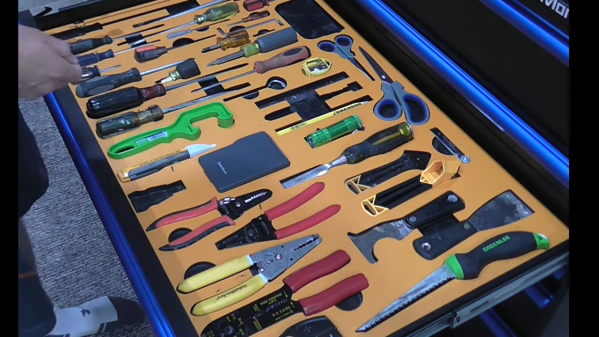We’ve been harping a lot lately about the effort by carmakers to kill off AM radio, ostensibly because making EVs that don’t emit enough electromagnetic interference to swamp broadcast signals is a practical impossibility. In the US, push-back from lawmakers — no doubt spurred by radio industry lobbyists — has put the brakes on the move a bit, on the understandable grounds that an entire emergency communication system largely centered around AM radio has been in place for the last seven decades or so. Not so in Japan, though, as thirteen of the nation’s 47 broadcasters have voluntarily shut down their AM transmitters in what’s billed as an “impact study” by the Ministry of Internal Affairs and Communications. The request for the study actually came from the broadcasters, with one being quoted in a hearing on the matter as “hop[ing] that AM broadcasting will be promptly discontinued.” So the writing is apparently on the wall for AM radio in Japan.
shadow6 Articles
No Tool Left Behind With The Help Of Homemade Shadow Boards
Shadowed tool storage — where a tool outline shows at a glance what’s missing from storage — is a really smart way to keep your shop neat. They’re also super important for cases where a tool left behind could be a tragedy. Think, where’s-that-10-mm-socket-while-working-on-a-jet-engine? important. (It’s always the 10-mm socket.)
But just because shadow boards are smart, doesn’t mean they’re easy to make. That’s why [Scott Prince] came up with this semi-automated method for making toolbox shadow boards. The job of tracing around each tool on some sort of suitable material and cutting out the shapes seems straightforward, but the trick comes in organizing the outlines given the space available and the particular collection of tools.
[Scott]’s method starts with capturing images of each individual tool. He used a PiCam and a lightbox housed, strangely enough, in a storage bench; we’d love to hear the full story behind that, but pretty much any digital camera would do for the job. After compensating for distortion with OpenCV, cropping the images, and turning the image into a vector outline of the tool, [Scott] was left with the task of putting the tools into logical groups and laying them out sensibly. After tweaking the tool outlines and adding finger cutouts for easy pickup, [Scott] put his CNC router to work. He chose to use a high-density polyethylene product made by his employer, which looks fantastic, but MDF would work fine too.
We have to admit to a fair degree of toolbox envy now that we’ve seen what shadow boards can do. We’re a bit torn, though — [Zach Friedman]’s Gridfinity storage system has a lot going for it, too.
Shadow Lamp Moves Delibrately Slowly
Inspired by the famous lava lamp, [Mojoptix] wanted to build a creation of his own with a similarly organic, changing lighting effect. However, rather than flowing heated wax, he created a lamp with pseudo-random effects his own way.
The lamp itself is built around a shadow-puppet concept, using a pair of rotating apetures that [Mojoptix] 3D printed. The apetures turn, one in front of the other, and are lit from behind by an IKEA LED light. As the apetures rotate, they present a slowly varying path for the light from the LED, which is projected onto a paper screen placed in in front of the assembly. To generate the long-period rotation, the rotating assembly is turned by the minute hand of a common clock movement. It’s a great way to get a slow-rotating motor and gearbox setup on the cheap, as long as your torque requirements are absolutely miniscule.
It’s a neat way to produce a slowly-varying lighting effect; we’ve featured other discussions on the topic before, too. Video after the break.
Shadow Buttons

This art installation uses buttons made of light. A projector fills up the walls and ceiling of a room while a webcam monitors the pattern for changes. When the luminosity of a given area changes due to a shadow, a midi event is triggered. The software that controls the system is written in C# and uses the Emgu CV library to handle the image processing. In the video after the break you can see that creating shadows with your hands prompts changes in the image as well as the sound.
The Bulbdial Clock Comes To Life

Evil Mad Scientist Laboratories has built the bulbdial clock, an idea originated by Ironic Sans. It’s basically a high definition indoor sundial. The LEDs arranged in a circle shine a light on the peg in the middle casting a shadow, just like a sundial. There are 3 colors of rings, allowing for hour, minute, and second shadows. This isn’t the first time that Ironic Sans has seen ideas come to reality. There were the pre pixelated reality show clothes and the sneaky histogram hidden message system. While it is a cute idea, it isn’t really new. People have been patenting this idea for a while.
Scratch Built Air Muscles

We first talked about air muscles in 2005 while lusting after Shadow Robotic’s dexterous hand. The pneumatic devices are known for being lightweight and compliant. They’re designed to be used in robot arms and legs. [jelengar] stumbled across this guide to building your own air muscles. We’re not exactly sure what the original source is since it reads like a machine translation. The core is a piece of silicone tubing used in aquariums. It’s sealed at one end with a bolt. Braided electrical sheathing is slid over the tube and secured using multiple wraps of 24gauge wire. They say to test it using 20psi, but there’s no mention of what the limits are.














